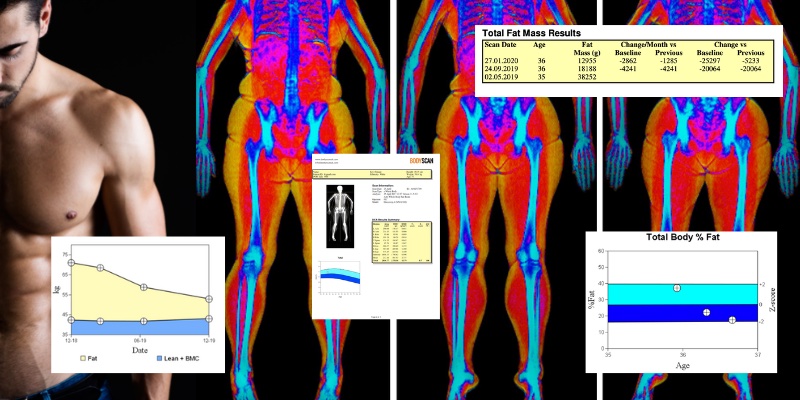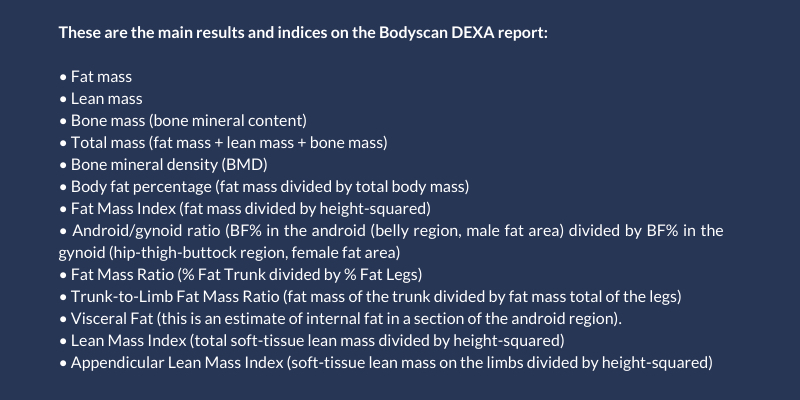
BLOG
What Does A DEXA Body Scan Show Me?

At the simplest level, a DEXA body composition scan shows how much fat, lean mass and bone you have in your body.
DEXA scans are universally regarded as the ‘gold standard’ for measuring body composition, meaning it will give you the most accurate, precise and consistent results for measuring and tracking changes in your body over time. To put it simply and bluntly, a DEXA scan is the best way to show exactly how fat you are!
Two of the three elements (or ‘compartments’) that a DEXA scan measures are easy to understand – fat mass and bone mass.
Your fat mass includes all body fat – the subcutaneous fat under your skin that you can pinch, the small amounts of intramuscular fat between your muscle fibres, and the unseen, internal fat that surrounds your organs, known as visceral (or ‘bad’) fat.
Your bone mass is basically the weight of your entire skeleton. It’s known more technically as your ‘bone mineral content’ (BMC) and refers to your bones free of all marrow and cartilage. It surprises most people, but this ‘dry weight’ of a human skeleton is incredibly light, typically less than 2.5kg for a woman and under 3.5kg for a man.
The third compartment a DEXA body scan measures is everything that’s not fat or bone, and this is referred to as ‘lean mass’. Therefore it includes your muscles, internal organs, skin, tendons, ligaments, etc – all fat-free soft tissue. It’s important to note that lean mass also includes water.
When reading and interpreting a DEXA scan report, it is acceptable and common practice to read lean mass as if it were skeletal muscle mass, making a DEXA scan, at the simplest level, a precise and consistent method for measuring fat, muscle and bone.
Lean mass is a very good proxy for muscle mass because about half or more of your lean mass is indeed skeletal muscle. That said, Bodyscan’s extensive experience of more than 21,000 scans has shown that significant changes in body water can affect the lean mass result. Common reasons for swings in body water are steroid use; creatine; menstruation; the early stages of weight-loss through calorie reduction (glycogen depletion); carb-loading or depletion, etc.
Your DEXA scan report will show you your total fat mass, lean mass and bone mass, measured in grams.
In Bodyscan’s view, DEXA’s greatest strength is the accuracy and consistency for measuring body fat. In other words: if your body fat changes, even by a small amount, a DEXA scan will faithfully record that change. Conversely, if a DEXA scan shows a change in your body fat, it means it is a true change and not the result of human error, dehydration or some other external factor.
What detail does a DEXA scan give?
A DEXA scan report is totally data-driven. Apart from the 2D colour image that represents fat, lean mass and bone, the report contains no qualitative information at all, it is all numbers. You’ll get the most information and the most value from your report by having it interpreted by experts who understand what each data point means. Since 2015, Bodyscan has performed and interpreted far more DEXA scans than anyone else in the UK and Europe and can provide you with the most meaningful and comprehensive explanation of your results.
The video below explains why it’s so important for your DEXA scan report to be interpreted and why the numbers can only have meaning when they are compared to and plotted against a very large dataset.
Most people who have a DEXA scan immediately look for their body fat percentage, which is on the front page of the report. That’s the single number most people want to know.
But as well as body fat percentage not being a very good measure of your level of body fat, there is much deeper, broader and more useful information in the rest of the report.
What does a DEXA provide in terms of fat and muscle?
The best measure of how fat and how muscled you are is conveyed in two numbers – your Fat Mass Index and Lean Mass Index. These equate to how much fat and muscle (actually, lean mass) you carry in relation to your height.
FMI and LMI are much better measures than body fat percentage because they are independent of each other (physiologically and numerically). FMI is unaffected by muscle, and LMI is unaffected by fat.
Because these numbers will be new to you (as will most of the numbers on the DEXA scan report), you’ll need a reference point to understand what is high and what is low. This is why a big and broad dataset against which you can compare your own data is crucial. Bodyscan’s dataset is the biggest there is.
Below are FMI and LMI tables for women and men. ‘Low fat’ would be an FMI at or below the 25th percentile. Therefore, ‘low body fat’ in the female table below for a woman of 43 years old would mean a fat mass index of about 6.3 (half-way between the 20th and 30th percentiles of 5.96 and 6.66).
Female percentile tables for Fat Mass Index and Lean Mass Index
Using the male tables below, average muscle mass for a man in his thirties would mean a lean mass index of 19.1 (the 50th or midway percentile).
Male percentile tables for Fat Mass Index and Lean Mass Index
Your FMI and LMI are the best numbers to use for setting fat-loss and muscle-gain targets. Bodyscan’s body composition calculator enables us to lower your FMI to a given percentile and advise you how many kilos of fat we think you should lose, how many calories you should eat per day and how long it will take you to reach that target. Specific, measurable targets that you can track over time.
What information does a DEXA scan give about fat and muscle distribution?
Within the report, a DEXA scan shows three results that inform us directly of your fat distribution.
Fat distribution
The fat distribution results are ratios that compare body fat in different parts of the body.
- Android/Gynoid Ratio
This is the ratio of your body fat percentage in the android (belly) region compared to the gynoid (hips and thighs) region.
- Fat Mass Ratio
This ratio compares the body fat percentage in your upper body (the trunk) to that in your legs.
- Trunk/Limb Fat Mass Ratio
The ratio of the total fat mass in your trunk to the fat mass in your arms and legs combined.
From a health perspective it is desirable that all these results are not greater than 1.0 for a man and 0.8 for a woman. Higher numbers tell us that you are carrying proportionally too much fat in the belly region but beware – remember these points:
- You cannot change your fat distribution because you cannot spot-lose fat in specific areas of the body. Some people (and ethnicities, such as those of South Asian heritage) naturally carry a higher proportion of their fat in their upper body, so will have naturally occurring higher fat distribution results than others.
- The distribution ratios do not tell us how much fat you have, only where it is stored. So you can have low fat and high ratios, or high fat and low ratios. As we age and/or increase fat levels, both sexes tend to store excess fat in the upper body. High levels of body fat stored mainly in the upper body is not a healthy position to be in as this leads to higher levels of visceral fat (internal fat around the organs), which is associated with life-changing diseases.
Muscle distribution
Muscle distribution between the left and right limbs is easy to read straight from the report but differences here are usually insignificant; it is common to have around a 10% muscle imbalance between your left and right sides.
Much more significant are muscle variations between your arms, legs and trunk, and this information is not in the report – it can only be assessed by plotting your data against a broad dataset (such as Bodyscan’s).
Does a DEXA scan show me Visceral Fat?
Of all the numbers on your DEXA scan report, it is the result for visceral fat that is the biggest ‘red flag’ for health. Visceral fat is fat stored around the internal organs and is associated with a range of serious diseases, including heart disease, colon cancer, stroke, type-2 diabetes and even dementia.
Whilst it is not a direct measurement of fat surrounding your organs (you will need an MRI or CT scan to see that level of detail), the DEXA scan result (obtained by measuring internal fat in a sliver of your belly) is closely correlated with CT-scan results and is very consistent.
A result below 100 is considered normal (and the lower the better) but the significance of your score varies by age, sex, ethnicity and lifestyle. Your score may be below 100 but it could actually be high for you. Again, you will need an expert interpretation to put your result into context.
What about bone density?
DEXA was invented to measure bone density and detect osteopenia and osteoporosis but bone scans are different to body scans.
A DEXA body scan will provide a good indication of your bone density but it is only that – an indication. It is not a definitive, diagnosable result upon which a doctor would make any firm decisions. However, if the indication was unusually high or low then we would advise you to see your GP or get specialist advice.
What does a DEXA scan show me? Summary
As you can see, a DEXA scan, expertly interpreted and explained, gives you a huge amount of meaningful information that you can use to achieve a healthier body composition. Get in touch with us today to book yourself a DEXA scan.


